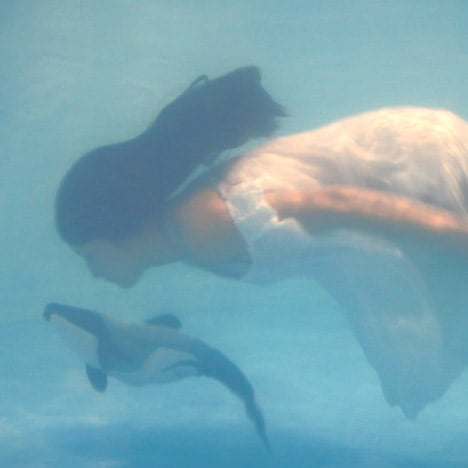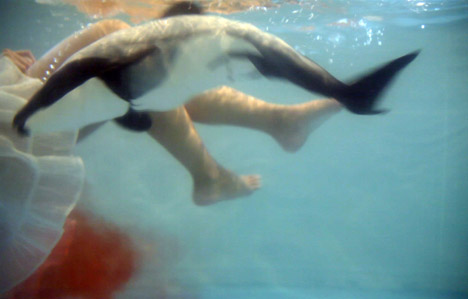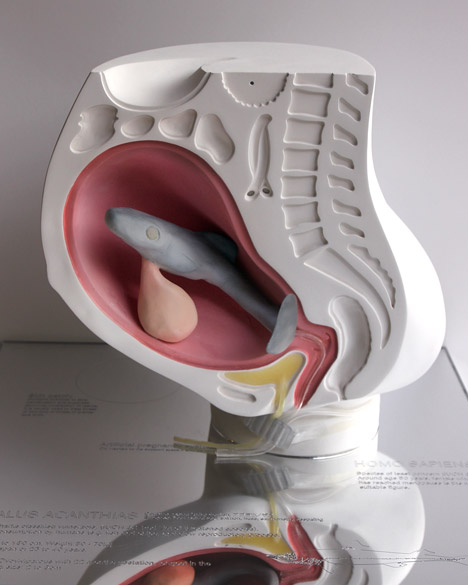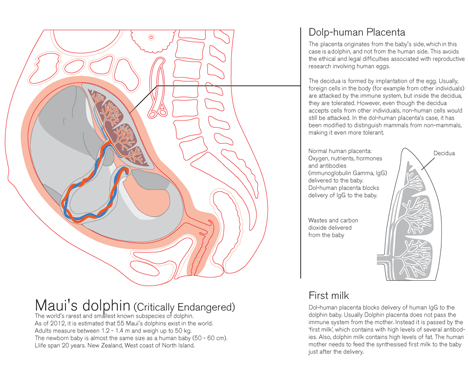I Wanna Deliver A Dolphin... concept for humans giving birth to their food by Ai Hasegawa
This synthetic biology project by designer Ai Hasegawa imagines that a woman could gestate and give birth to a baby from another species, in this case a dolphin, before eating it (+ movie).

I Wanna Deliver a Dolphin... was developed by Ai Hasegawa to tackle food shortages and satisfy maternal instincts as the human population burgeons by giving women the option to become surrogates for endangered animals hunted for food.
Hasegawa proposes synthesising a placenta that could support an animal in a human womb.
"This project approaches the problem of human reproduction in an age of overcrowding, overdevelopment and environmental crisis," Hasegawa said. "With potential food shortages and a population of nearly seven billion people, would a woman consider incubating and giving birth to an endangered species such as a shark, tuna or dolphin?"

The designer also questions whether someone would feel differently about eating a delicacy having personally carried and nurtured it.
"Would raising this animal as a child change its value so drastically that we would be unable to consume it because it would be imbued with the love of motherhood?" asked Hasegawa.
As a case study for the concept Hasegawa chose the Maui's dolphin, one of the world's smallest and most rare species of dolphin that has been critically endangered as a consequence of human fishing.

A Maui's dolphin is roughly the same size as a human baby and is regarded as highly intelligent.
For a woman to gestate a dolphin, Hasegawa proposes biologically modifying a placenta to prevent the passage of antibodies from mother to baby that attack non-human cells.
"The placenta originates from the baby's side, which in this case is a dolphin, and not from the human side," said Hasegawa. "This avoids the ethical and legal difficulties associated with reproductive research involving human eggs."
The "dolp-human" placenta would be altered to distinguish between mammal and non-mammal cells, rather than human and other cells, so the foetus would escape attack from the antibodies.

After birth, the mother would have to administer fat-rich synthesised milk to the baby to build it's immune system, which a dolphin would naturally get from its mother's milk rather than via the placenta.
Hasegawa first showed the idea at the Royal College of Art graduate show earlier this year and the project is currently on display as part of Grow Your Own... Life After Nature, an exhibition of synthetic biology projects at the Science Gallery in Dublin.
The exhibition also features synthetic living creatures that could be released into the wild to save endangered species and a proposal to use animal cells to print new types of organs for preventing heart attacks or strokes.
Here's the information from Ai Hasegawa:
I Wanna Deliver A Dolphin...
Humans are genetically predisposed to raise children as a way of passing on their genes to the next generation. For some, the struggle to raise a child in decent conditions is becoming harder due to gross overpopulation and an increasingly strained global environment.
This project approaches the problem of human reproduction in an age of overcrowding, overdevelopment and environmental crisis. With potential food shortages and a population of nearly seven billion people, would a woman consider incubating and giving birth to an endangered species such as a shark, tuna or dolphin? This project introduces the argument for giving birth to our food to satisfy our demands for nutrition and childbirth, and discusses some of the technical details of how this might be possible.
Would raising this animal as a child change its value so drastically that we would be unable to consume it because it would be imbued with the love of motherhood? The Maui's dolphin has been chosen as the ideal "baby" for this piece. It is one of the world's rarest and smallest dolphins, classified critically endangered by the International Union for Conservation's Red List of Threatened Species (version 2.3) because of the side effects of fishing activity by humans, its size (which closely matches the size of a human baby), and its high intelligence level and communication abilities.
I Wanna Deliver a Dolphin... imagines a point in the future, where humans will help this species by the advanced technology of synthetic biology. A "dolp-human placenta" that allows a human female to deliver a dolphin is created, and thus humans can become a surrogate mother to endangered species. Furthermore, gourmets would be able to enjoy the luxury of eating a rare animal: an animal made by their own body, raising questions of the ownership of rare animal life, and life itself.

Synthetic Dolp-human Placenta
To make it possible for a human mother to deliver a dolphin from her womb, there is a need to synthesise "The Dolp-human Placenta". The usual human placenta interacts to pass from mother to baby oxygen, carbon dioxide, nutrients, hormones, antibodies (Immunoglobulin Gamma, IgG) and so on. The Dolp-human placenta blocks the delivery of IgG to the baby.
The placenta originates from the baby's side, which in this case is a dolphin, and not from the human side. This avoids the ethical and legal difficulties associated with reproductive research involving human eggs.
The decidua is formed by implantation of the egg. Usually, foreign cells in the body (for example from other individuals) are attacked by the immune system, but inside the decidua they are tolerated. However, even though the decidua accepts cells from other individuals, non-human cells would still be attacked. In the dolp-human placenta case, it has been modified to distinguish mammal from non-mammal cells, making it even more tolerant.